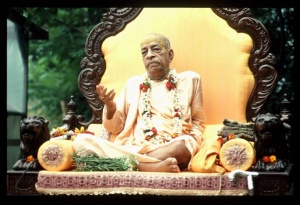CC Adi 10.90 (1975): Difference between revisions
(Vanibot #0027: CCMirror - Mirror CC's 1996 edition to form a basis for 1975) |
(Vanibot #0020: VersionCompareLinker - added a link to the Version Compare feature) |
||
| Line 2: | Line 2: | ||
<div style="float:left">'''[[Sri Caitanya-caritamrta (1975)|Śrī Caitanya-caritāmṛta (1975)]] - [[CC Adi (1975)|Ādi-līlā]] - [[CC Adi 10 (1975)|Chapter 10: The Trunk, Branches and Subbranches of the Caitanya Tree]]'''</div> | <div style="float:left">'''[[Sri Caitanya-caritamrta (1975)|Śrī Caitanya-caritāmṛta (1975)]] - [[CC Adi (1975)|Ādi-līlā]] - [[CC Adi 10 (1975)|Chapter 10: The Trunk, Branches and Subbranches of the Caitanya Tree]]'''</div> | ||
<div style="float:right">[[File:Go-previous.png|link=CC Adi 10.89 (1975)|Ādi-līlā 10.89]] '''[[CC Adi 10.89 (1975)|Ādi-līlā 10.89]] - [[CC Adi 10.91 (1975)|Ādi-līlā 10.91]]''' [[File:Go-next.png|link=CC Adi 10.91 (1975)|Ādi-līlā 10.91]]</div> | <div style="float:right">[[File:Go-previous.png|link=CC Adi 10.89 (1975)|Ādi-līlā 10.89]] '''[[CC Adi 10.89 (1975)|Ādi-līlā 10.89]] - [[CC Adi 10.91 (1975)|Ādi-līlā 10.91]]''' [[File:Go-next.png|link=CC Adi 10.91 (1975)|Ādi-līlā 10.91]]</div> | ||
{{CompareVersions|CC|Adi 10.90|CC 1975|CC 1996}} | |||
{{RandomImage}} | {{RandomImage}} | ||
==== TEXT 90 ==== | ==== TEXT 90 ==== | ||
| Line 32: | Line 31: | ||
<div class="purport"> | <div class="purport"> | ||
The spot where we now find Śrī Rādhā-kuṇḍa was an agricultural field during the time of Caitanya Mahāprabhu. A small reservoir of water was there, and Śrī Caitanya Mahāprabhu bathed in that water and pointed out that originally Rādhā-kuṇḍa existed in that location. Following His directions, Śrīla Rūpa Gosvāmī and Sanātana Gosvāmī renovated Rādhā-kuṇḍa. This is one of the brilliant examples of how the Gosvāmīs excavated lost places of pilgrimage. Similarly, it is through the endeavor of the Gosvāmīs that all the important temples | The spot where we now find Śrī Rādhā-kuṇḍa was an agricultural field during the time of Caitanya Mahāprabhu. A small reservoir of water was there, and Śrī Caitanya Mahāprabhu bathed in that water and pointed out that originally Rādhā-kuṇḍa existed in that location. Following His directions, Śrīla Rūpa Gosvāmī and Sanātana Gosvāmī renovated Rādhā-kuṇḍa. This is one of the brilliant examples of how the Gosvāmīs excavated lost places of pilgrimage. Similarly, it is through the endeavor of the Gosvāmīs that all the important temples at Vṛndāvana were established. Originally there were seven important Gauḍīya Vaiṣṇava temples established in Vṛndāvana, namely, the Madana-mohana temple, Govinda temple, Gopīnātha temple, Śrī Rādhāramaṇa temple, Rādhā-Śyāmasundara temple, Rādhā-Dāmodara temple and Gokulānanda temple. | ||
</div> | </div> | ||
Latest revision as of 14:27, 26 January 2020

A.C. Bhaktivedanta Swami Prabhupada
TEXT 90
- śāstra-dṛṣṭye kaila lupta-tīrthera uddhāra
- vṛndāvane kaila śrīmūrti-sevāra pracāra
SYNONYMS
śāstra-dṛṣṭye—according to the directions of revealed scriptures; kaila—did; lupta—forgotten; tīrthera—places of pilgrimage; uddhāra—excavation; vṛndāvane—in Vṛndāvana; kaila—did; śrī-mūrti—Deity; sevāra—of worship; pracāra—propagation.
TRANSLATION
In accordance with the directions of the revealed scriptures, both Gosvāmīs excavated the lost places of pilgrimage and inaugurated the worship of Deities in Vṛndāvana.
PURPORT
The spot where we now find Śrī Rādhā-kuṇḍa was an agricultural field during the time of Caitanya Mahāprabhu. A small reservoir of water was there, and Śrī Caitanya Mahāprabhu bathed in that water and pointed out that originally Rādhā-kuṇḍa existed in that location. Following His directions, Śrīla Rūpa Gosvāmī and Sanātana Gosvāmī renovated Rādhā-kuṇḍa. This is one of the brilliant examples of how the Gosvāmīs excavated lost places of pilgrimage. Similarly, it is through the endeavor of the Gosvāmīs that all the important temples at Vṛndāvana were established. Originally there were seven important Gauḍīya Vaiṣṇava temples established in Vṛndāvana, namely, the Madana-mohana temple, Govinda temple, Gopīnātha temple, Śrī Rādhāramaṇa temple, Rādhā-Śyāmasundara temple, Rādhā-Dāmodara temple and Gokulānanda temple.